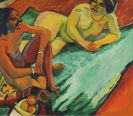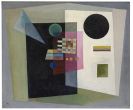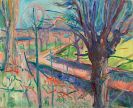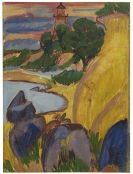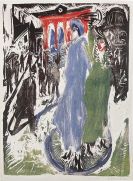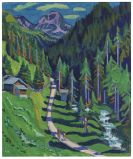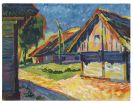
Heinrich Campendonk
Krefeld
1889 -
Amsterdam
1957
After his studies under the Dutch artist Johan Thorn Prikker at the Krefeld "Kunstgewerbeschule", Heinrich Campendonk followed Franz Marc's invitation to the Bavarian village of Sindelsdorf and moved there in 1911. At that time Heinrich Campendonk already found the basic subject of his works: the depiction of harmony between man and beast, Creation, the infinite circle of life and death. He produced paintings, watercolors, gouaches and his first woodcuts.
In Sindelsdorf the artist met other members of the "Blauer Reiter" group and participated in one of the group's exhibitions that very same year. Two years later, Heinrich Campendonk also showed his work together with the "Blauer Reiter" at the "Erster Deutscher Herbstsalon" at Herwarth Walden's gallery "Der Sturm" in Berlin.
During these years Campendonk's artwork was influenced by Marc, Macke and Kandinsky. A stiff geometrical form language was combined with color in pure complementary contrasts to a dynamic, rhythmic form language.
In 1916 Heinrich Campendonk moved to Seeshaupt at the Starnberger See, from where he went on extensive travels. At that point Campendonk's painting was marked by softly flowing forms, large calm areas of intensive light and lyrical, often fairytale-like mood. He also produced works in glass painting. In 1926 Campendonk was appointed professor at the Düsseldorf art academy.
Campendonk gained acclaim as an artist since the mid-1920s particularly through numerous glass windows he made for churches and public buildings (such as the Düsseldorf parliament building and the Paulskirche and the Essen Münster etc.). When he was dismissed form his teaching profession in 1933 he emigrated to Beligium, where he accepted a teching position for "monumental and decorative art" at the "Rijksakademie van beeldende Kunsten" in Amsterdam.
After the end of the war, Campendonk did not return to Germany. He continued to work as a teacher and received numerous orders for glass windows in the Netherlands and Germany. In 1956 Campendonk was awarded the Quellinus Prize by the city of Amsterdam and made knight of the order "De Nederlandse Leeuw".
Heinrich Campendonk died in Amsterdam in 1957.
Would you like to sell a work by Heinrich Campendonk?
Infos for seller

